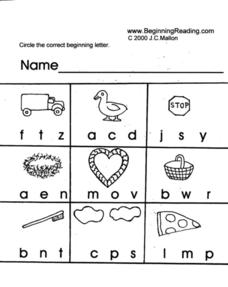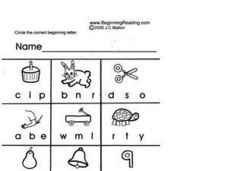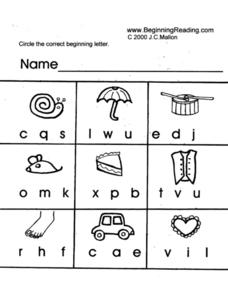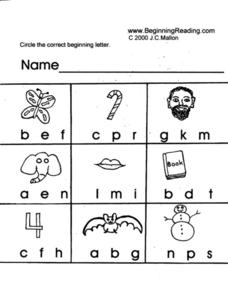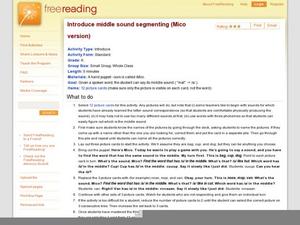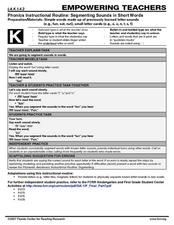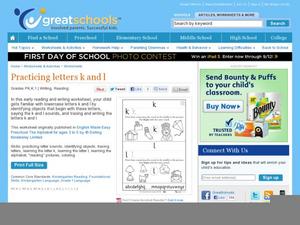Curated OER
Beginning Letters
In this initial consonant worksheet, students analyze 9 pictures of common objects. From a list of 3 choices, students circle the beginning letter of the word.
Curated OER
Beginning Letter
In this initial consonant worksheet, students analyze 9 pictures of common objects. From 3 choices of beginning consonant letters, students circle the correct choice.
Curated OER
Correct Beginning Letter
In this initial consonant worksheet, students analyze 9 pictures of common objects. From a list of 3 choices, students circle the beginning letter of the word.
Curated OER
Beginning Consonants
In this initial consonant worksheet, learners analyze 9 pictures of common objects. From a list of 3 choices, students circle the beginning letter of the word.
Curated OER
Introduce /r/
Use these inventive strategies to focus on the letter r, forming sound associations along with letter recognition. Explain the tongue movement in making the /r/ sound, asking learners to try it. Draw the r on the board and give...
Curated OER
Introduce /t/
What sound does the letter t make? As scholars develop letter recognition, form sound associations with strategies like these. Explain the tongue movement in making the /t/ sound, asking learners to try it. Draw the t on the...
Curated OER
Introduce Middle Sounds Segmenting (Mico Version)
Mico the puppet offers a phoneme challenge for emerging readers: can they find the object with the middle sound they hear? Use the fantastic set of full-color picture cards to play this game with small groups or even the whole class....
Curated OER
Building Fluency
As your youngsters begin to recognize the letters of the alphabet and their correponsding sounds, there are some they will be more familiar with than others. Cement their letter associations using this quick strategy, shown here with the...
Curated OER
First Sound Segmenting Accuracy
What's the sound, Mico? Use your class' favorite puppet (in this example, Mico) to teach them about initial sounds in single-syllable words. Using the picture cards provided, choose three and lay them out in front of learners. When Mico...
Curated OER
Introduce Onset-Rime Blending
Mico (or your favorite puppet) helps emergent readers recognize words from segmented phonemes. Explain to learners that he struggles with pronouncing words and needs their help. Model how Mico segments sounds in single-syllable words....
Curated OER
Odd One Out
Practice lowercase letters i-n with this initial sounds worksheet. There is a row of three objects for each of these letters, and scholars examine them to determine which does not begin with the letter sound. This would work best with...
Curated OER
Phonics: Read and Write Words with a Consonant Blend
Reading often times starts with phonemic awareness and letter sound correspondence. Get little ones blending those letter sounds together to read and write simple words. As the teacher sounds out each word, learners count phonemes, and...
Curated OER
Phonemic Awareness: Blending
First graders listen closely as their teacher sounds out a variety of words, one phoneme at a time. They then practice blending sounds to create words on their own. Tip: While you sound out words have your class write down each phoneme...
Curated OER
Phonics: Decode and Write Words with Blends
Kids see, say, then count the phonemes they hear in a series of simple words. They practice counting phonemes with the teacher, then sound out the same word on their own. As they count each phoneme they write it down on their paper. A...
Curated OER
Phonics: Segmenting Sounds in Short Words
F-u-n spells fun. It is a simple word that little learners can sound out as they build phonemic awareness and those early reading skills. This short scripted lesson provides teachers with the basics for teaching how to sound out...
Curated OER
Match the Rhymes
Tree, bee, knee, three... what do these have in common? Focus on vowel sounds in this matching worksheet for beginning readers. Learners connect a picture of a tree to pictures that rhyme with it and then get some printing practice. All...
Curated OER
Smart Board Syllable Activity
Students divide words, using syllable division rules. They divide two and three syllable words. They follow Orton-Gillingham rules and use the first three division rules.
Curated OER
Combining Syllables to Form 2- and 3-Syllable Words
Students practice combining consonant-vowel-consonant sounds to form words. They read closed and silent "e" syllables. Students construct two-syllable words. They arrange syllables to form three and four syllable words.
Curated OER
Odd One Out
There is one object that doesn't belong in each of these sets. Scholars circle the one that doesn't rhyme, listening for the /o/ vowel sound (long and short) in the others. They connect two of the objects to printing practice,...
Curated OER
Phonemic Awareness: Segmenting
You ever feel like your going in circles? Because this lesson seems very much like others I've seen. First graders put up a finger as they count each phoneme the teacher emphasises as she says a series of words.
Curated OER
Decode and Write Words with More Than One Syllable
Practice sounding out multi-syllable words with this scaffolded lesson. Learners decode words by segmenting them into phonemes and combining the sounds. Your lines are in bold here, but you can easily use this simply as an outline...
Curated OER
Practicing Letters k and l
Let's get to know the lowercase letters k and l. Scholars become familiar with both in this visual matching instructional activity. After tracing and printing each letter, they add them to an incomplete alphabet. Then, they draw lines...
Curated OER
Find the Letters
Help beginning readers recognize that whole words are made up of individual letters. They examine a set of lowercase letters and circle the ones they find in a CVC word. Learners do this for the words bin and cup.
Curated OER
Phonics: Segmenting Words with two or three phonemes
Kindergarteners build phonemic awareness by segmenting words with two or three phonemes. As the teacher says each word, the kids put up a finger for each phoneme they hear. This can also be done with manipulative such as blocks or tally...


